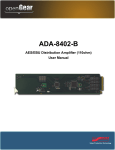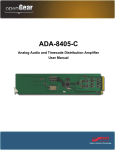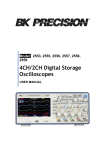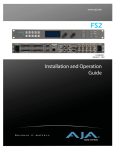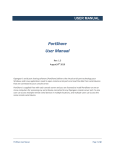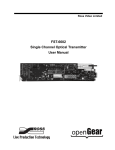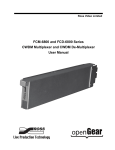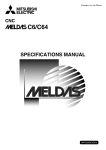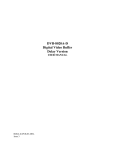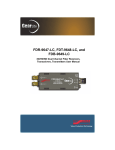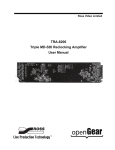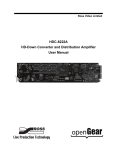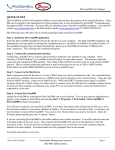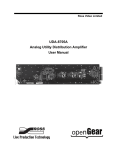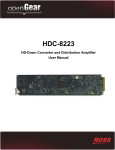Download QSP-8229A User Manual
Transcript
QSP-8229A Quad Split User Manual QSP-8229A User Manual • Ross Part Number: 8229ADR-004-01 • Release Date: June 15, 2012. The information in this manual is subject to change without notice or obligation. Copyright © 2012 Ross Video Limited. All rights reserved. Contents of this publication may not be reproduced in any form without the written permission of Ross Video Limited. Reproduction or reverse engineering of copyrighted software is prohibited. Patents This product is protected by the following US Patents: 4,205,346; 5,115,314; 5,280,346; 5,561,404; 7,304,886; 7,508,455; 7,602,446; 7,834,886; 7,914,332. This product is protected by the following Canadian Patents: 2039277; 1237518; 1127289. Other patents pending. Notice The material in this manual is furnished for informational use only. It is subject to change without notice and should not be construed as commitment by Ross Video Limited. Ross Video Limited assumes no responsibility or liability for errors or inaccuracies that may appear in this manual. Trademarks • is a registered trademark of Ross Video Limited. • Ross, ROSS, ROSS®, and MLE are registered trademarks of Ross Video Limited. • openGear® is a registered trademark of Ross Video Limited. • DashBoard Control System™ is a trademark of Ross Video Limited. • SanDisk® and CompactFlash® are registered trademarks of SanDisk Corporation, registered in the United States and other countries. • All other product names and any registered and unregistered trademarks mentioned in this manual are used for identification purposes only and remain the exclusive property of their respective owners. Important Regulatory and Safety Notices to Service Personnel Before using this product and nay associated equipment, refer to the “Important Safety Instructions” listed below to avoid personnel injury and to prevent product damage. Product may require specific equipment, and/or installation procedures to be carried out to satisfy certain regulatory compliance requirements. Notices have been included in this publication to call attention to these specific requirements. Symbol Meanings This symbol on the equipment refers you to important operating and maintenance (servicing) instructions within the Product Manual Documentation. Failure to heed this information may present a major risk of damage to persons or equipment. Warning — The symbol with the word “Warning” within the equipment manual indicates a potentially hazardous situation, which, if not avoided, could result in death or serious injury. Caution — The symbol with the word “Caution” within the equipment manual indicates a potentially hazardous situation, which, if not avoided, may result in minor or moderate injury. It may also be used to alert against unsafe practices. Notice — The symbol with the word “Notice” within the equipment manual indicates a potentially hazardous situation, which, if not avoided, may result in major or minor equipment damage or a situation which could place the equipment in a non-compliant operating state. ESD Susceptibility — This symbol is used to alert the user that an electrical or electronic device or assembly is susceptible to damage from an ESD event. Important Safety Instructions Caution — This product is intended to be a component product of the DFR-8300 series frame. Refer to the DFR-8300 Series Frame User Manual for important safety instructions regarding the proper installation and safe operation of the frame as well as its component products. Warning — Certain parts of this equipment namely the power supply area still present a safety hazard, with the power switch in the OFF position. To avoid electrical shock, disconnect all A/C power cords from the chassis’ rear appliance connectors before servicing this area. Warning — Service barriers within this product are intended to protect the operator and service personnel from hazardous voltages. For continued safety, replace all barriers after any servicing. This product contains safety critical parts, which if incorrectly replaced may present a risk of fire or electrical shock. Components contained with the product’s power supplies and power supply area, are not intended to be customer serviced and should be returned to the factory for repair. To reduce the risk of fire, replacement fuses must be the same time and rating. Only use attachments/accessories specified by the manufacturer. Warning — This product includes an “Ethernet Port” which allows this product to be connected to a local area network (LAN). Only connect to networks that remain inside the building. Do not connect to networks that go outside the building. EMC Notices United States of America FCC Part 15 This equipment has been tested and found to comply with the limits for a class A Digital device, pursuant to part 15 of the FCC Rules. These limits are designed to provide reasonable protection against harmful interference when the equipment is operated in a commercial environment. This equipment generates, uses, and can radiate radio frequency energy and, if not installed and used in accordance with the instruction manual, may cause harmful interference to radio communications. Operation of this equipment in a residential area is likely to cause harmful interference in which case the user will be required to correct the interference at their own expense. Notice — Changes or modifications to this equipment not expressly approved by Ross Video Limited could void the user’s authority to operate this equipment. CANADA This Class “A” digital apparatus complies with Canadian ICES-003. Cet appariel numerique de la classe “A” est conforme a la norme NMB-003 du Canada. EUROPE This equipment is in compliance with the essential requirements and other relevant provisions of CE Directive 93/68/EEC. INTERNATIONAL This equipment has been tested to CISPR 22:1997 along with amendments A1:2000 and A2:2002, and found to comply with the limits for a Class A Digital device. Notice — This is a Class A product. In domestic environments, this product may cause radio interference, in which case the user may have to take adequate measures. Maintenance/User Serviceable Parts Routine maintenance to this openGear product is not required. This product contains no user serviceable parts. If the module does not appear to be working properly, please contact Technical Support using the numbers listed under the “Contact Us” section on the last page of this manual. All openGear products are covered by a generous 5-year warranty and will be repaired without charge for materials or labor within this period. See the “Warranty and Repair Policy” section in this manual for details. Environmental Information The equipment that you purchased required the extraction and use of natural resources for its production. It may contain hazardous substances that could impact health and the environment. To avoid the potential release of those substances into the environment and to diminish the need for the extraction of natural resources, Ross Video encourages you to use the appropriate take-back systems. These systems will reuse or recycle most of the materials from your end-of-life equipment in an environmentally friendly and health conscious manner. The crossed out wheelie bin symbol invites you to use these systems. If you need more information on the collection, re-use, and recycling systems, please contact your local or regional waste administration. You can also contact Ross Video for more information on the environmental performance of our products. Company Address Ross Video Limited Ross Video Incorporated 8 John Street P.O. Box 880 Iroquois, Ontario, K0E 1K0 Ogdensburg, New York Canada USA 13669-0880 General Business Office: (+1) 613 • 652 • 4886 Fax: (+1) 613 • 652 • 4425 Technical Support: (+1) 613 • 652 • 4886 After Hours Emergency: (+1) 613 • 349 • 0006 E-mail (Technical Support): [email protected] E-mail (General Information): [email protected] Website: http://www.rossvideo.com Contents Introduction 1 In This Chapter .................................................................................................................... 1-1 Overview.............................................................................................................................. 1-2 Features.................................................................................................................. 1-2 Functional Block Diagrams ................................................................................................. 1-3 Non-Looping Configuration (8310AR-033, 8320AR-033) .................................. 1-3 Looping Configuration (8320AR-049).................................................................. 1-4 Documentation Terms.......................................................................................................... 1-5 Installation 2 In This Chapter .................................................................................................................... 2-1 Before You Begin ................................................................................................................ 2-2 Card Overview ..................................................................................................................... 2-3 Card-edge LEDs .................................................................................................... 2-4 Card Installation................................................................................................................... 2-5 Rear Modules......................................................................................................... 2-5 Installing the Rear Modules................................................................................... 2-6 Cabling Overview ................................................................................................................ 2-8 Non-Looping Rear Modules (8310AR-033, 8320AR-033) .................................. 2-8 Looping Rear Module (8320AR-049) ................................................................... 2-9 Ethernet Port Cabling......................................................................................................... 2-10 Ethernet Communication Cabling ....................................................................... 2-10 GPI Cabling ....................................................................................................................... 2-11 GPI Cable Connections ....................................................................................... 2-11 Tally Cabling ..................................................................................................................... 2-12 GPI Port Cabling ................................................................................................. 2-12 Serial Port Cabling .............................................................................................. 2-12 Ethernet Port Cabling .......................................................................................... 2-13 Configuration 3 In This Chapter .................................................................................................................... 3-1 Selecting the Video Format and Reference Source ............................................................. 3-2 Selecting the Video Format and Reference Source............................................... 3-2 Output Format Reference Compatibility ............................................................... 3-3 Video Input and Output Configuration ................................................................................ 3-4 Configuring the Video Outputs ............................................................................. 3-4 Configuring the Input Signal Timing Display....................................................... 3-5 Signal Loss Alarm Setup ....................................................................................... 3-5 Ethernet Communication Setup ........................................................................................... 3-7 GPI Communication Setup .................................................................................................. 3-8 GPI Overview........................................................................................................ 3-8 GPI Communication Setup.................................................................................... 3-8 Tally Communication Setup .............................................................................................. 3-10 Enable the Tally UMD Feature ........................................................................... 3-10 Set up Communications....................................................................................... 3-10 QSP-8229A User Manual (Iss. 01) Contents • i Loading the Factory Defaults............................................................................................. 3-14 Software Upgrades ............................................................................................................. 3-15 Operation 4 In This Chapter..................................................................................................................... 4-1 Adjusting the Proc Amp Controls ........................................................................................ 4-2 Configuring the Quad Split Sources .................................................................................... 4-4 Assigning Sources to the Quad Split ..................................................................... 4-4 Applying a Border ................................................................................................. 4-5 Notes on Timing................................................................................................................... 4-6 Appendix A. DashBoard Menus 5 In This Appendix.................................................................................................................. 5-1 Status Tabs ........................................................................................................................... 5-2 Signal Tab .............................................................................................................. 5-2 Hardware Tab ........................................................................................................ 5-3 Configuration Tabs............................................................................................................... 5-5 Video Configuration .............................................................................................. 5-5 GPI/Tally Configuration ........................................................................................ 5-6 Ethernet Configuration .......................................................................................... 5-8 Personality Configuration ...................................................................................... 5-9 Load/Save .............................................................................................................. 5-9 Proc Amps Tab................................................................................................................... 5-10 Quad Split Tabs.................................................................................................................. 5-11 Video/Label Tab .................................................................................................. 5-11 Tally/Border Tab ................................................................................................. 5-11 Bkgd A, B, C, D Tabs.......................................................................................... 5-12 Appendix B. Specifications 6 In This Appendix.................................................................................................................. 6-1 8310AR-033 and 8320AR-033 Specifications..................................................................... 6-2 8320AR-049 Specifications ................................................................................................. 6-3 Appendix C. Service Information 7 In This Chapter..................................................................................................................... 7-1 Troubleshooting Checklist ................................................................................................... 7-2 Warranty and Repair Policy ................................................................................................. 7-3 ii • Contents QSP-8229A User Manual (Iss. 01) Introduction In This Chapter This chapter contains the following sections: • Overview • Functional Block Diagrams • Documentation Terms A Word of Thanks Congratulations on your purchase of the openGear QSP-8229A Quad Split. The QSP-8229A is part of a full line of Ross Video products which are backed by over 25 years of engineering and design expertise. You will be pleased at how easily your new card fits into your overall working environment. Equally pleasing is the product quality, reliability, and functionality. Should you have a question pertaining to the installation or operation of your QSP-8229A, please contact us at the numbers listed in the section “Contact Us” located at the back of this manual. Our technical support staff is always available for consultation, training, or service. QSP-8229A User Manual (Iss. 01) Introduction • 1–1 Overview The QSP-8229A takes four SDI input streams and can reduce them into four quadrants in a single stream. The QSP-8229A has four SDI outputs which can be independently configured to display either the full-screen input or the Quad Split stream. When the output is showing full-screen, all HANC and VANC data, including the embedded audio data on the input is carried through to the output. When the output is showing Quad Split, all HANC and VANC data, including embedded audio, is stripped. In addition, the 8320AR-049 Rear Module was designed to be used with the QSP-8229A in the DFR-8321 series frames to loop its inputs to a system, such as the Carbonite® production switcher, for a multi-viewer application. GPI control allows external devices to choose which of the input selections, including the Quad Split, will be assigned to the outputs. Features The following features are included for the QSP-8229A: 1–2 • Introduction • Compliance with SDI SMPTE 292M (1.485Gbps) and SMPTE 259M (270Mbps) • Multi-Definition support of popular formats such as 1080i, 720p, 480i, 576i, 1080pSF • Assign any input, or Black, to any quadrant • Text overlay to name the four input sources in the Quad Split • Configure GPIs to trigger any of the outputs or a specific quadrant • On-screen tallies controlled by GPI, serial protocol (TSL UMD v3.1) or ethernet (TSL over UDP/TCP); quadrant text labels are updated dynamically • Specify how the input signal timing is reported (relative to the reference or the output) • Bypass relay from BKGD A input to Output 1 (8310AR-033 and 8320AR-033 Rear Modules only) • Four passive looping inputs (8320AR-049 Rear Module only) • User selectable card analog reference • Report status and configuration remotely via the DashBoard Control System™ • Ethernet 10/100 Mbit connectivity for easy upgrades in the field • Independent Proc-Amp control on outputs • Full DashBoard control and monitoring • Fully compliant with openGear specifications and installs in the DFR-8300 series frames • 5 year transferable warranty QSP-8229A User Manual (Iss. 01) Functional Block Diagrams This section provides the functional block diagrams for the QSP-8229A. Non-Looping Configuration (8310AR-033, 8320AR-033) This section includes the block diagram when using the QSP-8229A with the 8310AR-033 or 8320AR-033 Rear Modules. FRAME SYNC / VIDEO SCALER 4:1 FRAME SYNC / VIDEO SCALER 4:1 FRAME SYNC / VIDEO SCALER 4:1 FRAME SYNC / VIDEO SCALER 4:1 Figure 1.1 QSP-8229A Block Diagram — 8310AR-033 and 8310AR-033 Rear Modules QSP-8229A User Manual (Iss. 01) Introduction • 1–3 Looping Configuration (8320AR-049) This section includes the block diagram when using the QSP-8229A with the 8320AR-049 Rear Module. FRAME SYNC / VIDEO SCALER 4:1 FRAME SYNC / VIDEO SCALER 4:1 FRAME SYNC / VIDEO SCALER 4:1 FRAME SYNC / VIDEO SCALER 4:1 Figure 1.2 QSP-8229A Block Diagram — 8320AR-049 Rear Module 1–4 • Introduction QSP-8229A User Manual (Iss. 01) Documentation Terms The following terms are used throughout this manual: • All references to the DFR-8300 series frames also includes all versions of the 10-slot and 20-slot frames and any available options unless otherwise noted. • “Bkgd” refers to a Background source (A, B, C, or D). • “Board” or “Card” refers to the QSP-8229A, including all components and switches unless otherwise noted. • “DashBoard” refers to the DashBoard Control System™. • “LL” refers to the Lower Left quadrant. • “Looping Rear Module” refers to the 8320AR-049 Rear Module. • “LR” refers to the Lower Right quadrant. • “Non-looping rear module” refers to the 8310AR-033 or 8320AR-033 Rear Modules unless otherwise stated. • “Operator” and “User” refers to the person who uses the QSP-8229A. • “System” and “Video System” refers to the mix of interconnected digital and analog production equipment in which the QSP-8229A operates. • “UL” refers to the Upper Left quadrant. • “UR” refers to the Upper Right quadrant. QSP-8229A User Manual (Iss. 01) Introduction • 1–5 1–6 • Introduction QSP-8229A User Manual (Iss. 01) Installation In This Chapter This chapter provides instructions for the basic physical installation and communications setup of your QSP-8229A. The following topics are discussed: • Before You Begin • Card Overview • Card Installation • Cabling Overview • Ethernet Port Cabling • GPI Cabling • Tally Cabling QSP-8229A User Manual (Iss. 01) Installation • 2–1 Before You Begin Before you begin, ensure that you are using DashBoard version 4.0.0 or higher. The DashBoard Control System software and user manual are available to download from the Ross Video website. Static Discharge Throughout this chapter, please heed the following cautionary note: ESD Susceptibility — Static discharge can cause serious damage to sensitive semiconductor devices. Avoid handling circuit boards in high static environments such as carpeted areas and when synthetic fiber clothing is worn. Always exercise proper grounding precautions when working on circuit boards and related equipment. Unpacking Unpack each card you received from the shipping container and ensure that all items are included. If any items are missing or damaged, contact your sales representative or Ross Video directly. 2–2 • Installation QSP-8229A User Manual (Iss. 01) Card Overview This section provides an overview of the QSP-8229A components. Figure 2.1 Card-edge Components 1) CompactFlash® Card 3) JP5, JP6 2) Board Reset Button (SW1) 4) Reference Termination (JP7) 1. CompactFlash® Card The CompactFlash® card is reserved for future usage. 2. Board Reset Button (SW1) Pressing this button resets the microprocessor and re-initializes the card. This is a hard reset of the card and settings are not saved. This may cause loss of data and should only be performed as advised by Ross Video Technical Support. 3. JP5, JP6 These jumpers are not yet implemented and must be left in the default position of Pin 2 (center) and Pin 3 (bottom). 4. Reference Termination (JP7) JP7 is a 3-position jumper block used to configure the 75ohm termination on the local analog reference input on BNC 9 of the 8310AR-033 and 8320AR-033 Rear Modules, or BNC 11 of the 8320AR-049 Rear Module. • Pin 1 (left) + Pin 2 (center) position — In this position, the analog reference is terminated with an 75 Ohm resistor. This configuration is to be used for point-to-point cabling, or on the last card of a daisy chain topology. This is the default position (Figure 2.2). 1 2 3 Pin Position 1+2 Figure 2.2 JP7 — Default Position • Pin 2 (center) + Pin 3 (right) position — In this position, the 75ohm terminator is removed and the analog reference is not terminated. This configuration is used in a daisy chain cabling topology where only the last card is terminated. QSP-8229A User Manual (Iss. 01) Installation • 2–3 Card-edge LEDs This section describes the card-edge LEDs. Figure 2.3 outlines the locations of the card-edge controls. Figure 2.3 Card-edge Controls Table 2.1 LEDs on the Card-edge LED Color Green ERROR/OK Red Display and Description When this LED is green, the card is in normal operation with no errors. When this LED is red, the card is experiencing internal errors. Off When this LED is off, there is no power to the card. BKGD A STAT Green When this LED is green, the Bkgd A video input is valid. Red When this LED is red, the Bkgd A input is not present or is invalid. BKGD B STAT Green When this LED is green, the Bkgd B video input is valid. Red When this LED is red, the Bkgd B input is not present or is invalid. BKGD C STAT Green When this LED is green, the Bkgd C input is valid. Red When this LED is red, the Bkgd C input is not present or is invalid. BKGD D STAT Green When this LED is green, the Bkgd D input is valid. Red When this LED is red, the Bkgd D input is not present or is invalid. Green When this LED is green, the reference signal is valid. Red When this LED is red, the reference signal is not present or is invalid. REF STAT 2–4 • Installation QSP-8229A User Manual (Iss. 01) Card Installation This section provides a brief overview of the required Rear Modules and physical installation of the QSP-8229A. Note — The QSP-8229A requires either the 8310AR-033 or the 8320AR-033 Rear Module and therefore is not compatible with the DFR-8310-BNC frames. You must install the card with its 8310AR-033 Rear Module, occupying two slots in a DFR-8310-C, or a DFR-8310-N frame. To install the card in the DFR-8321 series frame, you must use the 8320AR-033 or 8320AR-049 Rear Module, with each rear module occupying four slots in the frame. Rear Modules The procedure for installing the Rear Module in your openGear frame is the same regardless of the frame or module used. However, a different module is required depending on the openGear frame you are using. The Rear Module requires two slots in an openGear DFR-8310 series frame and four slots in an DFR-8321 series frame. The rear module you install for the card depends on the frame you are using. • DFR-8310 series frame — Use the 8310AR-033 Rear Module. • DFR-8321 series frame — Use the 8320AR-033 or the 8320AR-049 Rear Modules. Power Fail Relay The 8310AR-033 or 8320AR-033 Rear Modules provide a built in bypass relay from BKGD A to Output 1 protects your on-air feed when the device is taken off-line and ensures critical program content is not lost. The purpose of this relay is as follows: • When the card is removed from the frame, the relay passes video from the BKGD A input to the Output 1 of the card. This allows the card to be serviced without interrupting the video signal. • If the card loses power, or the frame loses power, the video still passes through. • When the card boots, the relay will be left in Bypass mode until the card can generate a valid output. Once the card is up and functional, the relay is disabled. 8320AR-049 Rear Module The 8320AR-049 Rear Module provides a passive looping BNC on all four SDI inputs (Bkgd A, B, C, and D). The SDI source signal should be connected to the BNC IN input and if required, the SDI input signal may be propagated to one more downstream equipment using the associated BNC Loop output. Refer to the section “Looping Rear Module (8320AR-049)” on page 2-9 for BNC designations and for additional cabling information. • If you are using the BNC Loop output(s), then the looping SDI cable must drive only one piece of downstream equipment properly terminated with a 75ohm load at all time. If the downstream equipment must be disconnected for servicing, it is recommended to first disconnect the cable at the BNC Loop output of the 8320AR-049 Rear Module, otherwise the looping cable without termination will cause signal reflection that will likely corrupt the QSP-8229A SDI input signal. • If you are not using the looping output, then the BNC Loop should be left open without any cable or standalone 75ohm termination attached to the BNC. QSP-8229A User Manual (Iss. 01) Installation • 2–5 Installing the Rear Modules If the Rear Module is already installed, skip this section. To install a rear module in an DFR-8300 series frame 1. Refer to the DFR-8300 Series User Manual to ensure that the frame is properly installed according to instructions. 2. If you are installing the QSP-8229A in a DFR-8310 series frame, Ross Video recommends installing the Rear Module in one of the following combinations: • Slots 3, 4 • Slots 7, 8 • Slots 5, 6 • Slots 9, 10 Note — Ross Video does not recommend installing the card in the Slots 1,2 combination in a DFR-8310 series frame. This combination provides the least air flow cooling in the frame. 3. If you are installing the 8320AR-033 Rear Module in a DFR-8321 series frame, Ross Video recommends installing the Rear Module in one of the following combinations: • Slots 5, 6, 7, 8 • Slots 13, 14, 15, 16 • Slots 9, 10, 11, 12 • Slots 17, 18, 19, 20 Note — Ross Video does not recommend installing the card in the Slots 1,2, 3, 4 combination in a DFR-8321 series frame. This combination provides the least air flow cooling in the frame. 4. If you are installing the 8320AR-049 Rear Module in a DFR-8321 series frame, Ross Video recommends installing the Rear Module in one of the following combinations: • Slots 5, 6, 7, 8 • Slots 13, 14, 15, 16 • Slots 9, 10, 11, 12 • Slots 17, 18, 19, 20 5. Remove the Blank Plates from the rear of the selected card frame slots. 6. Seat the bottom of the Rear Module in the seating slot at the base of the backplane of the frame. 7. Align the top holes of the Rear Module with the screw holes on the top-edge of the frame backplane. 8. Verify that the QSP-8229A aligns with the Rear Module before fully tightening any of the slot screws. 9. Using a Phillips screwdriver and the supplied screws, fasten the Rear Module to the backplane. Do not over tighten. 10. Verify whether your Rear Module Label is self-adhesive by checking the back of the label for a thin wax sheet. You must remove the wax sheet before affixing the label. 11. Affix the supplied Rear Module Label to the BNC area of the Rear Module. 12. Ensure proper frame cooling and ventilation by having all rear frame rails covered with Rear Modules or Blank Plates. 2–6 • Installation QSP-8229A User Manual (Iss. 01) Installing the Card Use the following procedure to install the card in an DFR-8300 series frame: 1. Ensure that the DFR-8300 series frame is properly installed. 2. If you are installing the QSP-8229A in a DFR-8310 series frame, install the card into an odd-numbered slot (e.g. slot 5, 7, or 9). 3. If you are installing the QSP-8229A in a DFR-8321 series frame and depending on the rear module and slot combination you chose for the rear module, install the card into one of the following slots: • 8320AR-033 Rear Module — Install the card in slot 6, 10, 14, or 18. • 8320AR-049 Rear Module — Install the card in slot 7, 11, 15, or 19. 4. Hold the card by the edges and carefully align the card edges with the rails in the frame. 5. Fully insert the card into the frame until the card is properly seated in the Rear Module. QSP-8229A User Manual (Iss. 01) Installation • 2–7 Cabling Overview The QSP-8229A features four video inputs and four video outputs. This section provides general instructions for video input and output cabling the Rear Module for the cards. Non-Looping Rear Modules (8310AR-033, 8320AR-033) This section provides information when cabling the 8310AR-033 and 8320AR-033 Rear Modules. These rear modules do not support the looping feature. Refer to Figure 2.4 and Figure 2.5 for cabling designations when installing the 8310AR-033 and 8320AR-033 Rear Modules respectively. Figure 2.4 8310AR-033 Cable Connections Figure 2.5 8320AR-033 Cable Connections 1) GPI 1,2 Port 6) Ethernet 10/100 Port 11) OUT 2 BNC 2) GPI 3,4 Port 7) Bkgd B In BNC 12) OUT 1 BNC 3) GPI 5,6 Port 8) Bkgd C In BNC 13) OUT 4 BNC 4) GPI 7,8 Port 9) Bkgd A In BNC 14) OUT 3 BNC 5) Serial COM Port 10) Bkgd D In BNC 15) REF IN BNC Cabling for Non-Looping Rear Modules You can use up to 80m of industry standard 75ohm coaxial cable with these rear modules. Use the following procedure to connect video input and output cables to the Rear Module: 1. Connect the appropriate input video sources to the BNC connectors on the Rear Module. 2. Connect the output BNC connectors as required for your facility. 3. To use an external reference source other than the Frame Ref 1 and Frame Ref 2: 2–8 • Installation • Connect the reference input source to BNC 9. • Configure JP7 for the 75ohm termination on the local reference. Refer to the section “Card Overview” on page 2-3 for details. QSP-8229A User Manual (Iss. 01) Looping Rear Module (8320AR-049) The Looping feature is only available for the QSP-8229A when using the 8320AR-049 Rear Module in a DFR-8321 series frame. Refer to Figure 2.6 for cabling designations. Figure 2.6 8320AR-049 Cable Connections 1) Bkgd B In BNC 6) Bkgd A Loop Out BNC 11) REF IN BNC 16) GPI 3,4 Port 2) Bkgd B Loop Out BNC 7) Bkgd D Loop Out BNC 12) OUT 3 BNC 17) GPI 5,6 Port 3) Bkgd C Loop Out BNC 8) Bkgd D In BNC 13) OUT 4 BNC 18) GPI 7,8 Port 4) Bkgd C In BNC 9) OUT 1 BNC 14) Serial COM Port 19) Ethernet 10/100 Port 5) Bkgd A In BNC 10) OUT 2 BNC 15) GPI 1,2 Port Cabling for Looping Rear Modules Use the following procedure to connect video input and output cables to the Rear Module: 1. Refer to Table 2.2 for tested cable lengths. Note that other configurations respecting the total cable lengths are possible, but are not listed here. Table 2.2 Cabling Lengths for the 8320AR-049 Rear Module Configuration 270Mbps 1.5Gbps Input Cable Length Loop Cable Length Total Cable Length 145m 5m 150m 5m 145m 150m 50m 4m 54m 4m 50m 54m 2. Connect the appropriate input and output sources to the BNC connectors on the Rear Module. You do not need to terminate the Loop BNC(s) if you are not setting up a looping application. 3. To use an external reference source other than the Frame Ref 1 and Frame Ref 2: • Connect the reference input source to BNC 11. • Configure JP7 for the 75ohm termination on the local reference. Refer to the section “Card Overview” on page 2-3 for details. QSP-8229A User Manual (Iss. 01) Installation • 2–9 Ethernet Port Cabling The Ethernet 10/100 port on the Rear Module is used to connect to an ethernet network for communications, and software upgrades using the DashBoard Control System™. This section presents a general overview of the ethernet connection process. The exact steps for connecting your card to your facility via an ethernet network depends on the network requirements of your facility. Note — Contact your IT Department before connecting the card to your facility network to ensure that there are no conflicts. They will provide you with an appropriate value for the IP Address, Subnet Mask, and Gateway for the card. Ethernet Communication Cabling In order to properly complete this procedure, you need the following cables and equipment: • Ethernet Cable — This is a standard network CAT-5 cable to connect the card to your facility network. You can use a standard straight-through ethernet cable, with no need for a crossover cable as the card includes an Auto-MDIX ethernet PHY that will switch from straight to crossover automatically as needed. Ross Video does not supply this cable. To connect the card to an ethernet network 1. Ensure that you are running DashBoard Control System version 4.0.0 or higher before proceeding. The DashBoard Control System software and user manual are available to download from the Ross Video website. 2. Connect the card to the same subnet as your DashBoard computer or to a network that has a route to the network your DashBoard computer is on. Refer to the section “Cabling Overview” on page 2-8 for the Ethernet 10/100 port location on your Rear Module. 3. Make a note of the IP Address as this information is required when configuring the communication settings for your card. • Network topologies vary greatly between facilities. Contact your IT Department for assistance in connecting your card to the appropriate network at your location. For More Information... • 2–10 • Installation on setting up the ethernet communications for the card, refer to the section “Ethernet Communication Setup” on page 3-7. QSP-8229A User Manual (Iss. 01) GPI Cabling The QSP-8229A includes eight General Purpose Input (GPI) pins to interface with external equipment. There are eight input pins labelled GPIO 1-8 on the terminal block of the Rear Module (Figure 2.4, Figure 2.5, or Figure 2.6). Ports are pre-configured to be only an input (GPI). Electrically, the ports are setup for contact closure to ground, with a 1Kohms pull-up resistor to +5V, and default to a logical high state. Note — The default state for the GPI/O contacts is active low signalling. If a GPI cable is absent from the Rear Module, no GPI will be triggered and executed inadvertently by the card. GPI Cable Connections The GPI ports are available on four 3-pin WECO® connectors located on the Rear Module. Four 3-pin mating WECO® connectors are provided with the Rear Module. This section provides information for connecting GPI/Tally cables to the installed Rear Modules of your DFR-8300 series frame. To cable the rear module for GPIs 1. Locate the GPI ports on the Rear Module. Refer to the Rear Module labelling and Refer to the section “Cabling Overview” on page 2-8 for port locations. 2. Wire the GPI ports as follows: • The left and right pins are the two GPI signals while the center pin is the common Ground (GND). • Refer to Figure 2.7, Figure 2.8, or Figure 2.9 for GPI configuration on the Rear Module. Figure 2.7 8310AR-033 GPI Connections Figure 2.8 8320AR-033 GPI Connections Figure 2.9 8320AR-049 GPI Connections For More Information... • on setting up the communications for the GPI ports, refer to the section “GPI Communication Setup” on page 3-8. QSP-8229A User Manual (Iss. 01) Installation • 2–11 Tally Cabling There are three methods by which on-screen tallies can be controlled with the QSP-8229A: • GPI ports — Select this method to control tallies using the GPI ports on the QSP-8229A rear module. • Serial COM port — Select this method to control tallies using the Serial COM port on the QSP-8229A rear module. The TSL UMD protocol v3.1 is used to control the tallies. If you select this method, you must also configure the QSP-8229A serial communication port to accept TSL UMD protocol messages. • Ethernet 10/100 port — Select this method to control tallies using the TSL UMD protocol v3.1 over a UDP or TCP connection via the Ethernet 10/100 port on the QSP-8229A rear module. If you select this method, you must also configure the ethernet communication settings using the Remote Control tab. This section outlines the physical cabling requirements for setting up on-screen tallies for the QSP-8229A. To learn more about configuring the QSP-8229A for on-screen tally communication, refer to the section “Tally Communication Setup” on page 3-10. Note — Ensure that you do not enable more than one on-screen tally communication method at any given time. Doing so may cause unpredictable on-screen tally behavior. GPI Port Cabling To cable the GPI ports on the QSP-8229A rear module, refer to the section “GPI Cabling” on page 2-11 for details. To set up the GPI communications, refer to the section “Tally to GPI Setup” on page 3-10. Serial Port Cabling This section outlines how to cable serial communications for the QSP-8229A. In order to properly complete this procedure, you need the following cables and equipment: • Serial Interface Cable — This is a serial cable with a RJ-45 connector on one end and a connector on the other end to connect to your serial device. For the best performance, Ross Video recommends using a standard ethernet cable such as a CAT-5 or CAT-5e. Table 2.3 includes serial cable pinout details. Ross Video does not supply this cable. To set up serial communications for the card 1. Refer to Table 2.3 for pinout information for your required Serial Interface Cable. 2. Connect and secure the RJ-45 connector of the Serial Interface Cable to the Serial COM port on the Rear Module. 3. Connect and secure the other end of the Serial Interface Cable to the appropriate port on your serial device. Refer to the user manual for your serial device for pinout information and the required port to use. For More Information... • 2–12 • Installation on setting up the serial communications, refer to the section “Tally to Serial Setup” on page 3-11. QSP-8229A User Manual (Iss. 01) Serial COM Port Pin Assignment When building cables to interface to the card Serial COM port, it is recommended to use CAT-5 or CAT-5e cable with the standard ethernet wiring color coding. Table 2.3 shows the pin assignment of the Serial COM port located on the Rear Module. Table 2.3 RJ-45 Pin Assignment RJ45 Pin RS-232 RS-422 RS-422 Null 1 n/c Tx+ Rx+ 2 Rx Tx- Rx- 3 Tx Rx+ Tx+ 4a +12V +12V +12V 5a +12V +12V +12V 6 n/c Rx- Tx- 7 GND GND GND 8 GND GND GND Ethernet Port Cabling If you elect to control tallies using the Ethernet 10/100 port on the QSP-8229A rear module, refer to the section “Ethernet Port Cabling” on page 2-10 for cabling details. To set up the ethernet communications, refer to the section “Tally to Ethernet Setup” on page 3-12. QSP-8229A User Manual (Iss. 01) Installation • 2–13 2–14 • Installation QSP-8229A User Manual (Iss. 01) Configuration In This Chapter This chapter provides instructions for configuring the QSP-8229A using the options available in the DashBoard Control System™. The following topics are discussed: • Selecting the Video Format and Reference Source • Video Input and Output Configuration • Ethernet Communication Setup • GPI Communication Setup • Tally Communication Setup • Loading the Factory Defaults • Software Upgrades Note — Before proceeding, ensure that you are running DashBoard software version 4.0.0 or higher. The DashBoard Control System software and user manual are available to download from the Ross Video website. QSP-8229A User Manual (Iss. 01) Configuration • 3–1 Selecting the Video Format and Reference Source This section provides information for configuring the video and references formats for your card. Selecting the Video Format and Reference Source Use the following procedure to select the video format and reference source: 1. Display the Device tab of the card by double-clicking its status indicator in the Basic Tree View. 2. Display the Video tab as follows: • From the Device tab, select the Config tab. • Select the Video tab located at the bottom of the Config tab. Config Tab — Video Tab 3. Select the reference source from the Reference Input list. Choose from the following: • Frame 1 — Select this option to use the reference source connected to the FRAME REF 1 port on the DFR-8300 series frame. • Frame 2 — Select this option to use the reference source connected to the FRAME REF 2 port on the DFR-8300 series frame. • External — Select this option to use the external reference source connected to REF IN on the Rear Module. Use JP7 on the card to enable or disable a 75ohm terminator on the External Reference input. Refer to the section “Card Overview” on page 2-3 for information on configuring JP7. 4. Select the card output video format from the Output Format menu. Ensure that it is the same format as in the input video format. This completes the procedure for selecting the video format and reference source. Operating Tip — Use the Signal tab to monitor the Signal status, including the reference and the Background sources. Refer to the section “Status Tabs” on page 5-2 for more information. 3–2 • Configuration QSP-8229A User Manual (Iss. 01) Output Format Reference Compatibility Depending on the reference format you use, the card will only be able to operate in certain formats (Table 3.1). Table 3.1 Output/Reference Compatibility Reference 480i 59.94Hz Output 480i 59.94Hz 720p 59.94Hz 1080i 59.94Hz 576i 59.94Hz 720p 50Hz 1080i 50Hz 1080pSF 23.98Hz 1080pSF 24Hz 720p 59.94Hz 1080i 59.94Hz 576i 59.94Hz 1080pSF 23.98Hz 1080pSF 24Hz QSP-8229A User Manual (Iss. 01) 720p 50Hz 1080i 50Hz Configuration • 3–3 Video Input and Output Configuration Keep the following in mind when configuring your video inputs and outputs: • You can configure any of the four outputs independently to display the Quad Split or any of the backgrounds. Note that when a Bkgd source is fed through full screen, the ancillary data will also pass. • The Quad sources can be any of the four Background sources, or an internally generated black. • The Quad outputs are configured directly from the Quad Split tab. • Each output has a Proc Amp that can adjust parameters such as the black offset and gain. • All of the outputs can be enabled to add dither, clip to SMPTE black or allow super-black, or clip to SMPTE white or allow super-white. Configuring the Video Outputs Use the following procedure to configure your video outputs on the card: 1. Display the Device tab of the card by double-clicking its status indicator in the Basic Tree View. 2. Display the Video tab as follows: • From the Device tab, select the Config tab. • Select the Video tab located at the bottom of the Config tab. 3. From the Output Setup area, locate the Output BNC you want to configure. 4. Choose an output to configure as follows: • Output 1 — Select this field to configure the source on Output 1. • Output 2 — Select this field to configure the source on Output 2. • Output 3 — Select this field to configure the source on Output 3. • Output 4 — Select this field to configure the source on Output 4. 5. Select the output that you want to assign to the selected Output BNC from the corresponding Output field. You can choose between the following: • Quad Split — Select this option to assign the Quad Split to the selected output. • Bkgd A — Select this option to assign Bkgd A to the selected output. • Bkgd B — Select this option to assign Bkgd B to the selected output. • Bkgd C — Select this option to assign Bkgd C to the selected output. • Bkgd D — Select this option to assign Bkgd D to the selected output. 6. From the Dithering field, select the type of dithering you want to apply to all outputs. You can choose between the following: • Disabled — Select this option to disable the Dithering feature. • Enabled low — Select this option to enable 2 bit dithering. • Enabled medium — Select this option to enable 3 bit dithering. • Enabled high — Select this option to enable 4 bit dithering. 7. Enable the Clip White or Clip Black feature as follows: • 3–4 • Configuration Clip at Black — Select this box to enable the card to clip to SMPTE black on all outputs. An unchecked box allows super-black. QSP-8229A User Manual (Iss. 01) • Clip at White — Select this box to enable the card to clip to SMPTE white on all outputs. An unchecked box allows super-white. This completes the procedure for configuring your outputs on the card. Configuring the Input Signal Timing Display The Timing Display feature enables you to configure how the input signal timing is reported by DashBoard. This information is displayed in the Bkgd A, B, C, and D Timing fields of the Signal tab in the number of clocks and lines. Negative values indicate the input signal timing is earlier than the reference. Positive values indicate the input signal timing is later than the reference. Note that there are 4400 clocks per line when using the 1080i 59.94Hz format. Use the following procedure to configure the input signal timing for your QSP-8229A: 1. Display the Device tab of the card by double-clicking its status indicator in the Basic Tree View. 2. Display the Personality tab as follows: • From the Device tab, select the Config tab. • Select the Personality tab located at the bottom of the Config tab. 3. Configure how the signal timing by selecting one of the following options from the Timing Display menu: • • Relative to Reference — Select this option to display the timing offset values of the SDI inputs and output relative to the selected analog reference as follows: › A negative offset value indicates that the SDI signal is earlier than the analog reference. › A positive value indicates that the SDI signal is later than the analog reference. Input to Output — Select this option to display the timing offset values of the SDI BKGD inputs relative to the SDI output of the card as follows: › A negative offset value indicates that the SDI BKGD input signal is earlier than the SDI OUT signal. › A positive value indicates that the SDI BKGD input signal is later than the SDI OUT signal. This completes the procedure for configuring the input signal timing for your QSP-8229A. Signal Loss Alarm Setup The Signal Loss Alarm feature enables DashBoard to display status alarms when a loss of signal is experienced on the Background input sources. The alarm information displays in the Signal tab of DashBoard and on the card-edge LEDs. For more information on the status LEDs, refer to the section “Card-edge LEDs” on page 2-4. Use the following procedure to set up the Signal Loss Alarm feature: 1. Display the Device tab of the card by double-clicking its status indicator in the Basic Tree View. 2. Display the Video tab as follows: • From the Device tab, select the Config tab. • Select the Video tab located at the bottom of the Config tab. 3. Enable or disable the alarms by selecting or deselecting the required boxes in the Signal Loss Alarm area as follows: QSP-8229A User Manual (Iss. 01) Configuration • 3–5 • Bkgd A — Select this box to enable DashBoard to report the status of the Background A input source. • Bkgd B — Select this box to enable DashBoard to report the status of the Background B input source. • Bkgd C — Select this box to enable DashBoard to report the status of the Background C input source. • Bkgd D — Selecting this box enables DashBoard to report the status of the Background D input source. This completes the procedure for setting up the Signal Loss Alarm. 3–6 • Configuration QSP-8229A User Manual (Iss. 01) Ethernet Communication Setup To enable the card to perform software upgrades, the card must be configured with valid ethernet settings for the Ethernet 10/100 port on the Rear Module of the card. The settings can be specified manually (Static) or may be obtained automatically from a server on your network (DHCP). Use the following procedure to set up ethernet communications for the card: 1. Display the Device tab of the card by double-clicking its status indicator in the Basic Tree View. 2. Display the Ethernet tab as follows: • From the Device tab, select the Config tab. • Select the Ethernet tab located at the bottom of the Config tab. Config Tab — Ethernet Tab 3. To obtain network settings automatically: • Select DHCP from the Method drop-down list. • To save the new settings, click Apply Changes. Note that clicking Cancel will revert to the previous settings. 4. To manually configure the ethernet settings: • Select Static from the Method drop-down list. • Enter the IP Address, Subnet Mask, and Default Gateway settings for the card. • To save the new settings, click Apply Changes. Note that clicking Cancel will revert to the previous settings. This completes the procedure for setting up ethernet communications for the card. Note — The Ethernet Status field in the Ethernet tab displays the current status of your connection. Refer to Table 5.7 for a list of the messages. QSP-8229A User Manual (Iss. 01) Configuration • 3–7 GPI Communication Setup This section explains how to configure communications for GPIs on the card using the menus and options available in DashBoard. GPI Overview When configured as a GPI, a port behaves as an input, and can be used to trigger actions such as switching between the Quad Split display or full-screen BKGD input display. A push-button switch, or an ON-OFF switch, may be directly connected between the port and the adjacent ground pin. Minimum pulse duration is 1ms, anything shorter will be filtered out. GPI Communication Setup You can configure the GPI to control the display configuration. Each output can be set to display the Quad Split, a Bkgd source, or to cycle through the sources each time the specific GPI/Tally is triggered. Note — Each GPI should be set to a different function. Setting more than one GPI to the same function can cause unexpected behavior. Multiple GPIs can be set to None at the same time. Use the following procedure to configure remote control for GPIs: 1. Display the Device tab of the card by double-clicking its status indicator in the Basic Tree View. 2. Display the GPI/Tally tab as follows: • From the Device tab, select the Config tab. • Select the GPI/Tally tab located at the bottom of the Config tab. Config Tab — GPI/Tally Tab 3–8 • Configuration QSP-8229A User Manual (Iss. 01) 3. Assign a transition event to a GPI /Tally by selecting the function from the Function drop-down list to the required GPI/Tally. Choose from the following: • None — Select this option to not assign a function to the selected GPI/Tally. The Trigger and Polarity settings are ignored. This is the default setting. • Output xx - Quad — Selecting this option causes the specified output, where xx represents the output, to display the Quad Split when the GPI is triggered. • Output xx - Bkgd # — Selecting this option causes the specified output, where xx represents the output, to display the specified full-screen input when the GPI is triggered. • Output xx - Cycle — Selecting this option causes the specified output, where xx represents the output, to cycle through the Quad Split and full-screen inputs when the GPI is triggered. • yy Quad - Black — Selecting this option causes the specified quadrant, where yy represents the quadrant (UL, UR, LL, and LR), to show black when the GPI is triggered. • yy Quad - Bkgd # — Selecting this option causes the specified quadrant, where yy represents the quadrant, to show the specified Bkgd source when the GPI is triggered. • yy Quad - Cycle — Selecting this option causes the specified quadrant, where yy represents the quadrant, to cycle through Black and the four inputs when the GPI is triggered. • Bkgd # - Tally x — Selecting this option causes the GPI to control the specified tally, where x represents the tally number, associated with the specified Bkgd input. Refer to the section “Tally to GPI Setup” on page 3-10 for details. 4. Select a trigger for the GPI from the Trigger column. Choose from the following: • Edge — Select this option to configure the card to perform the Function on either the Rising or Falling Edge of the GPI signal as determined by the Polarity setting. • Level — Select this option to have the GPI action controlled by a static voltage level. The card performs the Function when the GPI state is either High or Low as determined by the Polarity set in step 5. The action triggered by the GPI input will remain in that state until the GPI level changes. Select this option when using a GPI to control a tally. 5. Select a polarity for the GPI from the Polarity column. Choose from the following: • High/Rising — Select this option to have the GPI triggered on a static High level, or on a Low-to-High pulse. • Low/Falling — Select this option to have the GPI triggered on a static Low level or on a High-to-Low pulse. This is the default setting. This completes the procedure for configuring remote control for GPIs. QSP-8229A User Manual (Iss. 01) Configuration • 3–9 Tally Communication Setup With the on-screen tally display feature, each quadrant of the QSP-8229A supports two tallies (for Program and Preview) with selectable position and color. Tallies can be shown as small circles, or can be drawn into the border surrounding each quadrant. Note that this feature is not enabled by default. This section explains how to enable and configure communications for on-screen tallies using the menus and options available in DashBoard. There are three steps: 1. Enable the Tally UMD Feature — The tally on-screen display feature is disabled by default. You must change the Tally Position menu item from the default value of None to one of the other three options. 2. Set up Communications — You must configure the correct type of communication between the device and the QSP-8229A based on the cabling performed in the section “Tally Cabling” on page 2-12. 3. Set up the Tally On-Screen Labels — Once communications are set up, you can assign a channel for each of the four card inputs, specify how the label information from the on-screen tally device will be processed, select the color of each on-screen tally, and determine the position of the on-screen tallies. Refer to the section “Set up the Tally On-Screen Labels” on page 3-12 for details. Enable the Tally UMD Feature Use the following procedure to enable the on-screen tally label display: 1. Display the Device tab of the QSP-8229A by double-clicking its status indicator in the Basic Tree View. 2. Display the Tally/Border tab as follows: • From the Device tab, select the Quad Split tab. • Select the Tally/Border tab located at the bottom of the Quad Split tab. 3. Assign the tally on-screen display positions by selecting one of the Tally Position options from the Tally Control area. Refer to the section “Tally/Border Tab” on page 5-11 for a list of options. Set up Communications This section provides instructions on how to set up the communications between the QSP-8229A and the on-screen tally device. The method for setting up communications depends on how the device is connected to your QSP-8229A. Tally to GPI Setup Note — Each GPI port should be set to a different function. Setting more than one GPI port to the same function can cause unexpected behavior. Multiple GPI ports can be set to None at the same time. This section outlines how to set up communications between your on-screen tally device and the QSP-8229A when using GPIs. 3–10 • Configuration QSP-8229A User Manual (Iss. 01) Use the following procedure to configure remote GPI control for on-screen tallies: 1. Display the Device tab of the QSP-8229A by double-clicking its status indicator in the Basic Tree View. 2. Display the GPI/Tally tab as follows: • From the Device tab, select the Config tab. • Select the GPI/Tally tab located at the bottom of the Config tab. 3. Assign an event to an on-screen tally by selecting the function from the Function drop-down list to the required tally. Choose from the following: • Bkgd # - Tally 1 — Select this option to have the GPI control the first on-screen tally associated with the specified input. • Bkgd # - Tally 2 — Select this option to have the GPI control the second on-screen tally associated with the specified input. 4. Set the Trigger to Level. This completes the procedure for configuring remote control for on-screen tallies via the GPI ports. Tally to Serial Setup The Serial Port area of the Remote Control tab includes options for configuring serial communications, using the TSL UMD v3.1 protocol, between the QSP-8229A and the serial device connected to the Serial COM port on the card rear module. This section outlines how to set up serial communications between your on-screen tally device and the QSP-8229A. Use the following procedure to configure remote serial control for on-screen tallies: 1. Display the Device tab of the QSP-8229A by double-clicking its status indicator in the Basic Tree View. 2. Display the Remote Control tab as follows: • From the Device tab, select the Config tab. • Select the Remote Control tab located at the bottom of the Config tab. Config Tab — Remote Control Tab 3. Select TSL UMD v3.1 from the Protocol menu. QSP-8229A User Manual (Iss. 01) Configuration • 3–11 4. Configure the Port Type, Bit Rate, Data Bits, Parity, and Stop Bits as required by the serial on-screen tally device connected to the QSP-8229A rear module. 5. Select the Port Enabled box to enable serial on-screen tally communication from the Serial COM port on the QSP-8229A rear module. This completes the procedure for configuring serial control for on-screen tallies. Tally to Ethernet Setup The Ethernet Protocol area of the Remote Control tab includes options for configuring communications for the Ethernet 10/100 port on the QSP-8229A rear module. This section outlines how to set up ethernet communications between your on-screen tally device and the QSP-8229A. Use the following procedure to configure ethernet communications to an on-screen tally device: 1. Display the Device tab of the QSP-8229A by double-clicking its status indicator in the Basic Tree View. 2. Display the Remote Control tab as follows: • From the Device tab, select the Config tab. • Select the Remote Control tab located at the bottom of the Config tab. 3. Specify the type of ethernet service for the QSP-8229A from the Role menu. Choose from the following: • Server — Select this option to enable the QSP-8229A to function as a host, or socket listener, on the network. This is the recommended setting. • Client — Select this option to configure the QSP-8229A to function as a service requester that initiates communications with a server. 4. Select the ethernet protocol used by your on-screen tally device from the Protocol menu. Choose from the following: • TCP — Select this option if your on-screen tally device uses the Transmission Control Protocol (TCP) for ethernet communications. • UDP — Select this option if your on-screen tally device uses the User Data Protocol (UDP) for ethernet communications. 5. Enter the port number for your on-screen tally device in the Local Port field. When the Role is set to Server, the QSP-8229A will listen on the specified port for incoming connections. 6. If you selected Client in step 3., specify the Remote IP Address and Remote Port number of the remote device to which the QSP-8229A should connect. For example, if you use an external ethernet-to-serial port expander, you would enter the IP address and port number of the serial port expander here. 7. Select the TSL UMD v3.1 box to enable ethernet communication from the Ethernet 10/100 port on the QSP-8229A rear module to the tally device. This completes the procedure for configure ethernet communications to an on-screen tally device. Set up the Tally On-Screen Labels The Quad Split tab includes a tab for each card input that enables you to assign a channel for each of the four card inputs, specify how the label information from the on-screen tally device will be processed, select the color (RGB format) of the border, and determine the position of the on-screen tallies. By default, the QSP-8229A displays the static label text as defined in the Bkgd field in the Quad Split sub-tab for a source. 3–12 • Configuration QSP-8229A User Manual (Iss. 01) To set the border color and size: 1. Display the Device tab of the QSP-8229A by double-clicking its status indicator in the Basic Tree View. 2. Display the Tally/Border tab as follows: • From the Device tab, select the Quad Split tab. • Select the Tally/Border tab located at the bottom of the Quad Split tab. 3. To set the border size for all sources, use the Border Size slider to adjust the thickness of the border in pixel units. As you adjust the thickness of the border, it expands inwards from the edge of the quadrant. A value of 0 removes the border. 4. To apply the same border color to all sources, select a specific color from the Border Color menu located in the Border Control area. 5. To apply a unique border color for a source: • Select Color from the Border Color menu. • Select the sub-tab for the source you wish to configure a unique border color for. • Use the Red, Green, Blue, and Transparent sliders to configure the border color for that source. To configure an input label content: 1. From the Quad Split tab, select the sub-tab for the card input you wish to configure. 2. If required, update the on-screen QSP-8229A static label for the input by typing a new name in the Bkgd field located at the top of the Label area. Operating Tip — When using long strings of text in labels, adding a space or hyphen to the QSP-8229A static label helps ensure proper spacing of the text when displayed on-screen. For example, if you are prepending the dynamic label information, add a hyphen at the beginning of the QSP-8229A static label. 3. If the TSL UMD protocol is enabled, the QSP-8229A can add the dynamic label provided by the protocol. Choose one of the following from the TSL UMD menu: • Ignore — Select this option to ignore the dynamic label information from the on-screen tally device and display only the QSP-8229A static label (as defined in step 2.). The TSL UMD protocol only controls the tally indicators. • Append — Select this option to display the dynamic label information after the QSP-8229A static label (as defined in step 2.). This is the default setting. • Prepend — Select this option to display the dynamic label information from the on-screen tally device before the QSP-8229A static label (as defined in step 2.). • Replace — Select this option to display only the dynamic label information and ignore the QSP-8229A static label. 4. Assign a channel for the card input by entering the source Display Address using the TSL Address slider. 5. Configure the area behind the tally source label for the specified card input as follows: • Use the sliders in the Color area to configure the color of the label area. • Use the Transparency slider to configure the appearance of the label area from opaque (0), through transparent, to fully off (100). QSP-8229A User Manual (Iss. 01) Configuration • 3–13 Loading the Factory Defaults If required, the card menu parameters can be reset to the factory default values using the option available in the Load/Save tab. Note — Ethernet settings, reference input selection, and the output formats are not reset using this method. To reset the card to the factory default configuration in DashBoard 1. Display the Device tab of the card by double-clicking its status indicator in the Basic Tree View. 2. Display the Load/Save tab as follows: • From the Device tab, select the Config tab. • Select the Load/Save tab located at the bottom of the Config tab. 3. From the Global Settings area, click Load Factory Defaults to display the Confirm dialog. 4. Press Yes to load the factory default values for all menu parameters, or No to cancel the load and close the dialog. 3–14 • Configuration QSP-8229A User Manual (Iss. 01) Software Upgrades The card can be upgraded in the field using the Ethernet 10/100 port on the Rear Module and using the options available in DashBoard. Refer to the section “Ethernet Communication Setup” on page 3-7 for setting up ethernet communications. Note — This procedure assumes that you are running DashBoard version 4.0.0 or higher. To upgrade the software on a card 1. Contact Ross Technical Support for the latest software version file. 2. Display the Device tab of the card by double-clicking its status indicator in the Basic Tree View. 3. From the Device tab, click Upload to display the Select file Upload dialog. 4. Navigate to the *.bin file you wish to upload. 5. Click Open. 6. If you are upgrading a single card, click Finish to start the upgrade. Proceed to step 8. 7. If you are upgrading multiple cards: • Click Next > to display the Select Destination menu. This menu provides a list of the compatible cards based on the card selected in step 2. • Specify the card(s) to upload the file to by selecting the check box(es) for the cards you wish to upload the file to. • Verify that the card(s) you wish to upload the file to. The Error/Warning fields indicate any errors, such as incompatible software or card type mismatch. • Click Finish. 8. Monitor the upgrade. • A Upload Status dialog enables you to monitor the upgrade process. • Note that if the ethernet connection is invalid, such as the ethernet cable is unplugged from the card rear module, the user is prompted to reboot the card when the upgrade is complete. If multiple cards are being upgraded, the user should wait for all to complete, before rebooting them. • The card is temporarily taken offline. • The reboot process is complete once the status indicators for the Card State and Connection return to their previous status. Operating Tip — If you are running DashBoard v2.3.0 or lower, you must click Reboot in the Device tab to complete the upgrade process. Troubleshooting If you encounter problems when upgrading your card software, verify the following: • Your network settings on the card are valid. Refer to Table 5.7 for a list of settings. • Ethernet cable is properly connected if you are uploading the file via a network connection. • The file you are attempting to load is a *.bin file that is for the card you are upgrading. QSP-8229A User Manual (Iss. 01) Configuration • 3–15 3–16 • Configuration QSP-8229A User Manual (Iss. 01) Operation In This Chapter This chapter provides a summary of the operational features, such as Proc Amp controls and assigning input sources to the Quad Split. The following topics are discussed: • Adjusting the Proc Amp Controls • Configuring the Quad Split Sources • Notes on Timing Note — Before proceeding, ensure that you are running DashBoard software version 4.0.0 or higher. The DashBoard Control System software and user manual are available for download from the Ross Video website. QSP-8229A User Manual (Iss. 01) Operation • 4–1 Adjusting the Proc Amp Controls Each output on the card has a Proc Amp that can adjust the black offset, the video gain, the chroma gain and the CB gain. This section briefly outlines how to adjust the options available in the Proc Amp tab. To adjust an output using a Proc Amp 1. Display the Device tab of the card by double-clicking its status indicator in the Basic Tree View. 2. Select an output signal to adjust as follows: • Select the Proc Amps tab. • Select the Output tab for the output signal you want to adjust. The Output tabs are located at the bottom of the Proc Amps tab. Proc Amps Tab — Out 1 - Program Tab 3. Select the Enable box to ensure the color adjustments are applied. The Enable box must be selected in order for any color correction to take effect on the selected output. 4. Adjust the Video Gain of the card video outputs as follows: • Use the Video Gain slider to adjust the amount of Video Gain you want to apply. Increasing overall gain causes an increase in contrast while also making colors more saturated and vivid. Decreasing overall gain causes a decrease in contrast while de-saturating colors. 5. Adjust the Chroma Gain of the card video outputs as follows: • Use the Chroma Gain slider to adjust the chrominance video signal components (Cr and Cb) simultaneously. Increasing the chroma gain value causes the video signal colors to become increasingly saturated and more vivid. Decreasing the chroma gain value de-saturates color from the video signal until it is black and white. 6. Adjust the CB Gain of the card video outputs as follows: 4–2 • Operation QSP-8229A User Manual (Iss. 01) • Use the CB Gain slider to adjust the Cb component of the chrominance video signal. Increasing the Cb Gain value causes the video signal colors to become increasingly saturated with blue. Decreasing the Cb Gain value desaturates blue from the video signal. 7. Adjust the Black Offset of the card video outputs as follows: • Use the Black Offset slider to adjust the Black Offset you want to apply. Increasing the Black Offset value causes a lightening effect. Decreasing the Black Offset value causes a darkening effect. Operating Tip — To reset the Proc Amp settings to the default values, click Reset and then Yes in the Confirm dialog box. QSP-8229A User Manual (Iss. 01) Operation • 4–3 Configuring the Quad Split Sources This section briefly describes how to set up your Quad Split sources using the Quad Split tab in DashBoard. From the Quad Split tab, you can assign any input to any quadrant and add a text label to display at the bottom of the applicable quadrant. All active video content will be visible, including the 480i Line 21 content. Note that when a loss of input in a quadrant occurs, the QSP-8229A fills that quadrant with a blue pattern. Note — The ancillary data (HANC and VANC) of the Quad Split is empty but filled with valid black. Assigning Sources to the Quad Split Use the following procedure to assign sources to a Quad Split quadrant: 1. Display the Device tab of the card by double-clicking its status indicator in the Basic Tree View. 2. From the Device tab, select the Quad Split tab. Quad Split — Video/Label Tab 3. Select the Video/Label tab. 4. Select the quadrant you wish to configure. 5. Assign a video source to the specific quadrant by selecting an option from the corresponding drop-down menu. Choose from the following: • Black — Select this option to assign black to the specific quadrant. • Bkgd A — Select this option to assign the Bkgd A input to the specific quadrant. • Bkgd B — Select this option to assign the Bkgd B input to the specific quadrant. • Bkgd C — Select this option to assign the Bkgd C input to the specific quadrant. • Bkgd D — Select this option to assign the Bkgd D input to the specific quadrant. 6. To apply a text label to the quadrant: • 4–4 • Operation Locate the Source Label area of the Quad Split tab. QSP-8229A User Manual (Iss. 01) • Enter a text label in the applicable text box for the input source. • Press Enter on your keyboard to apply the new text. Applying a Border The Border feature allows you to set the color (RGB format), transparency, and overall thickness of the border that is applied to the specified source. Borders are created from the outside edge of the quadrant and expand inward. The border is applicable to all quadrants. To adjust the border for all quadrants 1. Display the Device tab of the card by double-clicking its status indicator in the Basic Tree View. 2. From the Device tab, select the Quad Split tab. Quad Split — Tally/Border Tab 3. Select the Tally/Border tab. 4. Select a Border Color option from the Border Control area. Note that if you select Color, you can apply a different color to each source border as outlined in the section “To set the border color and size:” on page 3-13. 5. Use the Border Size slider to adjust the thickness of the border in pixel units. Notice that as you adjust the thickness of the border, it expands inwards from the edge of the quadrant. A value of 0 removes the border. QSP-8229A User Manual (Iss. 01) Operation • 4–5 Notes on Timing This section provides additional information on the timing features of the QSP-8229A: 4–6 • Operation • On the current software release, SDI output timing of the card is currently fixed at 0.5 line after the selected analog reference. For example, when using a 1080i output format, the Output Timing field in the Signal tab will be +2200 clocks because the output timing measurement is relative to the selected analog reference. • Each video input has a line sync that can support a full line of SD or HD video including horizontal blanking. • When showing full screen BKGD inputs (no Quad Split), line syncs are used and all BKGD video inputs must be timed within +/- 0.5 line offset from the selected analog reference. Exceeding this tolerance will result in shifting the full screen output display by one or several lines. • When using Quad Split, frame syncs are used and the BKGD video inputs do not need to be timed to the selected analog reference. The video scaling requires a frame store operation and the BKGD inputs will be delayed by up to one frame before it is displayed in the Quad Split quadrants. • All of the video outputs must be the same video format as the video inputs. If the formats do not match, the card reports an error in the DashBoard Signal Status area and on the card-edge LEDs. • When using Quad Split, inputs that are mis-timed will be aligned to the next frame boundary. • By default, DashBoard displays output timing relative to the reference. Signal timing is reported in Clocks and Lines. • Use the Timing Display option in the Personality tab to configure how DashBoard displays the input signal timing. You can choose to report the timing as relative to the output or relative to the reference. QSP-8229A User Manual (Iss. 01) Appendix A. DashBoard Menus In This Appendix The DashBoard Control System enables you to monitor and control openGear frames and cards from a computer. DashBoard communicates with cards in the openGear DFR-8300 series frames through a MFC-8300 Series Network Controller Card. This controller card is required in order to use DashBoard to monitor the QSP-8229A. Refer to the MFC-8300 Series User Manual for details. This appendix briefly summarizes the menus, items, and parameters available from the DashBoard Control System™ for the QSP-8229A. Default values are noted with an asterisk (*). The following topics are discussed: • Status Tabs • Configuration Tabs • Proc Amps Tab • Quad Split Tabs Note — Before proceeding, ensure that you are running DashBoard software version 4.0.0 or higher. The DashBoard Control System software and user manual are available to download from the Ross Video website (www.opengear.tv). QSP-8229A User Manual (Iss. 01) Appendix A. DashBoard Menus • 5–1 Status Tabs The following table summarizes the read-only information displayed in the Status tabs. The fields in the Signal tab vary in severity from green (valid), yellow (caution), to red (alarm). DashBoard reports the most severe alarm for a single field. Alarm colors are noted within the tables as text set in brackets next to the menu parameter name. Signal Tab Table 5.1 outlines the read-only information displayed in the Signal tab for the QSP-8229A. Table 5.1 Signal Tab Items Tab Title Item Reference Status Bkgd # Status Signal (Read-only) Bypass Relay Parameters Description OK (Green) Valid reference signal No reference (Red) No signal detected on selected reference input Reference Unlocked (Red) Signal detected, but not locked (or lock lost) Invalid Reference (Red) Signal detected, but incompatible with the current video mode OK (Green) Normal operation Alarm Suppressed (Green) An alarm condition exists but is silenced Incompatible (Yellow) The input video format is incompatible with the output format however the frame rates match Unsupported (Red) The input format is compatible with the output format however the frame rates differ No signal (Red) No signal present on the specified input Normal (not in bypass) (Green) Video is being routed through the card; Quad Split may be active Active (in bypass) (Red) BKGD A bypasses the card and is looped passively on Output 1 through the relay Relative to Reference The BKGD Timing fields display the timing values relative to the selected analog reference Input to Output The BKGD Timing fields display the timing values relative to the SDI output of the card Timing Display ## clocks ## lines Indicates the timing of the specified input signal relative to the reference signal or relative to the output as specified in the Timing Display feature where 1 clock is: • 1 period of 27MHz (SD), or • 1 period of 148.x MHz (HD) Bkgd # Timing 5–2 • Appendix A. DashBoard Menus (Green) Indicates that the timing is within the specified range for the card (Yellow) Indicates that the card is operating outside the specified line sync range. You may encounter vertical shifts and/or missing ancillary data when viewing at full-screen. QSP-8229A User Manual (Iss. 01) Table 5.1 Signal Tab Items Tab Title Signal (Read-only Item Parameters Description Bkgd # Timing (Gray) Indicates the absence of the specified input signal. Verify that the cable is properly secured to the rear module. Output Timing ## clocks ## lines Indicates the timing of the output signals relative to the reference Hardware Tab Table 5.2 outlines the read-only information displayed in the Hardware tab for the QSP-8229A. Table 5.2 Hardware Tab Items Tab Title Item Description OK (Green) Normal operation; no hardware errors and the correct rear module is installed Incomp I/O module (Red) Card is connected to the wrong rear module Alarm suppressed (Green) Rear module is incompatible and the Incompat Rear Module alarm is disabled Voltage (V) # Supply Voltage, in Volts Current (mA) # Current consumption of card in milliAmperes Power (W) # Power consumption of card in Watts FPGA Temp ##Ca / ##F FPGA core temperature FPGA Fanb # RPM Indicates the card fan speed CPU Usage x.xx / y.yy / z.zzc CPU Load average RAM Available ## / ## MB Memory Used / Total Memory #.## of 2.0 GB used Displays the amount of memory used on the CompactFlash card Missing CompactFlash card is not present Unreadable An error has occurred, such as incompatible CompactFlash card, or an error reading the card HW Status Hardware (Read-only) Parameters CF Card Status Displays RAM memory usage where: • a represents the memory in use • b represents the memory cache from previously loaded files Playout RAM a/b/c/d • c represents the memory dedicated to the frame sync buffers and related functions. Note that this memory is unavailable for images and animations. • d represents the total playout memory a. b. c. A warning is displayed in DashBoard when the FPGA Core Temperature reaches 85°C. If the temperature reaches 110°C, the card will automatically shut down to avoid permanent damage and will have to be reset, rebooted, or power cycled to resume normal operation. This field is displayed for QSP-8229A models (Board Rev 3 or higher). The CPU Load average is displayed in the following format where x.xx represents in the last minute, y.yy represents the last five minutes and z.zz is the last fifteen minutes. QSP-8229A User Manual (Iss. 01) Appendix A. DashBoard Menus • 5–3 Product Tab Table 5.2 outlines the read-only information displayed in the Hardware tab for the QSP-8229A. Table 5.3 Product Tab Items Tab Title Product (Read-only) Item Parameters Description Product QSP-8229A Supplier Ross Video Ltd. Board Rev ## Indicates the board version of your card Serial Number ########### Indicates the serial number of your card Rear Module # Indicates the type of Rear Module in the slot Software Rev #.# build ### Indicates the software and build versions Firmware Rev ##.## Indicates the FPGA version number 5–4 • Appendix A. DashBoard Menus QSP-8229A User Manual (Iss. 01) Configuration Tabs This section briefly summarizes the options and tabs available in the Config tab. Video Configuration Table 5.4 summarizes the Video tab options available in DashBoard. Table 5.4 Video Tab Options Menu Reference Setup Item The card is using Frame Reference 1 Frame 2 The card is using Frame Reference 2 The card is using the reference input on: External • BNC 9 (8310AR-033, 8320AR-033); or • BNC 11 (8320AR-049) Output 1 # Specifies the format of the output signal of the card Quad Split* Output 1 displays the Quad Split as configured using the options in the Quad Split tab Bkgd A Output 1 displays the Bkgd A source Bkgd B Output 1 displays the Bkgd B source Bkgd C Output 1 displays the Bkgd C source Bkgd D Output 1 displays the Bkgd D source Output 2 Same parameters as above. The default setting is Quad Split. Output 3 Same parameters as above. The default setting is Bkgd A. Output 4 Same parameters as above. The default setting is Bkgd B. Dithering Clip at Black Clip at White Signal Loss Alarm Description Frame 1* Reference Input Output Format Output Setup Parameters Disabled* Dithering is disabled Enabled - low Dithering is enabled and set to 2bits Enabled - medium Dithering is enabled and set to 3bits Enabled - high Dithering is enabled and set to 4bits Selected SuperBlack is clipped on all outputs Cleared* SuperBlack is not clipped Selected SuperWhite is clipped on all outputs Cleared* SuperWhite is not clipped Selected* An alarm is triggered when a missing or an invalid signal is detected on the specified input Cleared The alarm is suppressed when a missing or an invalid signal is detected on the specified input Bkgd # QSP-8229A User Manual (Iss. 01) Appendix A. DashBoard Menus • 5–5 GPI/Tally Configuration The menu items available in the GPI/Tally Setup tab enable you to configure the functions and polarity of each GPI connected to the QSP-8229A. Table 5.5 GPI/Tally Setup Menu Items Menu Item Parameter None* The port is not configured and the GPI has no effect Output # - Quad When triggered, the specified output displays the Quad Split Output # - Bkgd # When triggered, the specified output displays the specified Bkgd source at full-screen Output # - Cycle On each trigger, the output will cycle through the possible Bkgd sources, and the Quad Split # Quad - Black The specified quadrant displays black when the GPI is triggered # Quad - Bkgd # The specified quadrant displays the selected Bkgd source when the GPI is triggered # Quad - Cycle The specified quadrant output cycles through the available input sources and black when the GPI is triggered Bkgd # - Tally 1 Select this option to have the GPI control the first on-screen tally associated with the specified input on the QSP-8229A Bkgd # - Tally 2 Select this option to have the GPI control the second on-screen tally associated with the specified input on the QSP-8229A Edge* Performs the function when a transition edge is detected on the GPI input. The Low-to-High or High-to-Low active edge is set by the Polarity control. Level Performs the function when a voltage level is driven on the GPI input. The voltage level High or Low is set by the Polarity control. High/Rising Sets the polarity of the edge or level trigger. In the case of edge trigger, a Low-to-High transition starts the function. In the case of level trigger, a high level starts the function. Low/Falling* Sets the polarity of the edge or level trigger. In the case of the edge trigger, a High-to-Low transition starts the function. In the case of a level trigger, a low level starts the function. Function GPI # Trigger Polarity 5–6 • Appendix A. DashBoard Menus Description QSP-8229A User Manual (Iss. 01) Remote Control Configuration Table 5.6 outlines the options in the Remote Control tab for the QSP-8229A. This tab provides options for configuring communications between the QSP-8229A and tally device. Table 5.6 Remote Control Tab Items Menu Item Parameter Selected Cleared* Disables the Serial COM port Protocol TSL UMD v3.1 Selects the serial communication protocol for the external device connected to the Serial COM port on the rear module Port Type # Selects the electrical standard for the Serial COM port on the rear module. The default is RS 232. Bit Rate # Selects the bit rate for the external device connected to the Serial COM port. The default is 38400. Data Bits # Selects the number of data bits transmission (character length). The default is 8. Port Enabled Serial Port Parity Sets the Parity type. The default is None. # Sets the number of stop bits transmission. The default is 1. Selected Enables ethernet communication from the Ethernet 10/100 port on the QSP-8229A rear module to a device using the Tally Systems Ltd. (TSL) UMD protocol v3.1 Cleared* Disables the Ethernet 10/100 port for tallies Server* The QSP-8229A functions as a host, or socket listener, on the network Client The QSP-8229A functions as a service requester that initiates communications with a server TCP* Select this option if your device uses the Transmission Control Protocol (TCP) for ethernet communications UDP Select this option if your device uses the User Data Protocol (UDP) for ethernet communications Local Port # Specifies the port number for the tally device. The default is 9000. Remote IP Addressa # Specifies the IP Address for the server the QSP-8229A sends requests to. The default is 0.0.0.0. Remote Porta # Specifies the port number for the server the QSP-8229A sends requests to. The default is 0. Stop Bits TSL UMD v3.1 Enabled Role Ethernet Port Protocol a. Description Enables the Serial COM port on the rear module to communicate with a serial device This menu item is only applicable when Role is set to Client. QSP-8229A User Manual (Iss. 01) Appendix A. DashBoard Menus • 5–7 Ethernet Configuration Table 5.7 outlines the options in the Ethernet tab for the QSP-8229A. This tab provides options for configuring the ethernet communication for the QSP-8229A. Table 5.7 Ethernet Tab Items Menu Item Parameter Description Static User manually supplies the Ethernet Setup settings DHCP* Automates the assignment of the Ethernet settings IP Address ##.#.#.### The IP Address for the card Subnet Mask ###.#.#.# The subnet mask for the card Default Gateway ##.#.#.# The gateway for communication outside of the local area network (LAN) Method Apply Changes Applies and saves any changes made to the Ethernet Settings Cancel Cancels any setting changes and resets the Ethernet Settings to the previous values Ethernet OK Ethernet communications for the card are valid Link Down Ethernet communications for the card are invalid. The ethernet cable may be disconnected from the rear module or the network may be down. The following conditions are occurring: Ethernet Status • The Method is set to DHCP. No IP Address • The ethernet cable connected to card rear module is securely connected. • A valid IP Address is no longer available. The DHCP server may be down or is still powering up after a loss of power. MAC Address (read-only) 5–8 • Appendix A. DashBoard Menus ##:##:##:##:##:## The MAC Address for the card QSP-8229A User Manual (Iss. 01) Personality Configuration Table 5.8 outlines the options in the Personality tab for the QSP-8229A. Table 5.8 Personality Tab Items Menu Item Timing Display Card Lock Enable Fan Alarma a. Parameter Relative to Reference* Input to Output The BKGD A, B, C, D Timing fields in the Signal tab display the timing values relative to the SDI output of the card Unlocked* All menu items are unlocked and can be edited Locked All menu items, except this one, are locked and read-only. The card can still be controlled by GPI if this features was enabled prior to locking. Selected* The FPGA Fan field in the Signal tab reports when the fan on the card surface is not operating correctly Cleared Disables this reporting feature Timing Display Edit Permission Stalled Fan Description The BKGD A, B, C, D Timing fields in the Signal tab display the timing values relative to the selected analog reference This field is only displayed for when using Board Rev 3 or higher. Load/Save The menu items available in the Load/Save tab enable you to reset menu parameters for the card to the factory default values. Table 5.9 Load/Save Tab Items Menu Global Settings Item Load Factory Defaults QSP-8229A User Manual (Iss. 01) Parameter Description Resets all DashBoard parameters and values (excluding ethernet, reference, and output format settings) to the factory default values Appendix A. DashBoard Menus • 5–9 Proc Amps Tab The following table summarizes the Proc Amps tab options available in DashBoard. Table 5.10 Proc Amps Tab Items Menu Item Parameters Selected* Enables the adjustment of Proc Amp settings for the selected output Cleared The Proc Amp settings for the selected output are inactive 0 to 200a Adjusts the Chroma and Luma Gain values simultaneously Enable Video Gain (%) Description Adjusts the Cr and Cb values of the output video signals: Chroma Gain (%) 0 to 200b • Increasing the gain increases the saturation of colors • Decreasing the gain de-saturates the colors until the signal is black and white Adjusts the Cb component of the chrominance video signal: Out # CB Gain (%) 0 to 200c • Increasing the value causes the video signal colors to become increasingly saturated with blue • Decreasing the value de-saturates blue from the video signal Black Offset (IRE) -8 to 100d Selects how much of the input video signal values are mapped to black in the output signal: • Increasing the value increases the black level and lightens the image • Decreasing the value darkens the image Procamp a. b. c. d. Reset Resets the Proc Amp menu settings for the selected output to the default values The default value is 100. The default value is 100. The default value is 100. The default value is 0. 5–10 • Appendix A. DashBoard Menus QSP-8229A User Manual (Iss. 01) Quad Split Tabs The following tables summarize the Quad Split tab options available in DashBoard. Video/Label Tab Table 5.11 summarizes the options available in the Video/Label tab for the Quad Split. Table 5.11 Video/Label Tab Items Menu Item Parameters Upper Left Quadrant Selection Source Label Description Black The upper left quadrant displays black Bkgd A* The upper left quadrant displays the Bkgd A source Bkgd B The upper left quadrant displays the Bkgd B source Bkgd C The upper left quadrant displays the Bkgd C source Bkgd D The upper left quadrant displays the Bkgd D source Upper Right Same parameters as above. The default setting is Bkgd B. Lower Left Same parameters as above. The default setting is Bkgd C. Lower Right Same parameters as above. The default setting is Bkgd D. Bkgd A Bkgd A* Bkgd B Bkgd B* Bkgd C Bkgd C* Bkgd D Bkgd D* Enter text in this field to configure the label for the specified source. Note that a blank field hides the text overlay in the display quadrant. This label is applied to the Tally/Border tab items, the Bkgd # tab items, and the Config tab items. Tally/Border Tab Table 5.12 summarizes the options available in the Tally/Border tab for the Quad Split. Table 5.12 Tally/Border Tab Items Menu Item Parameters Description No tallies shown* Tally Position Tally Control Tally 1 on left, Tally 2 on right Assigns Tally 1 to the left, and Tally 2 to the right Tally 2 on left, Tally 1 on right Assigns Tally 1 to the right, and Tally 2 to the left Tallies displayed in border Tally Color QSP-8229A User Manual (Iss. 01) Tally 1 is red, Tally 2 is green* Tally 2 is red, Tally 1 is green Appendix A. DashBoard Menus • 5–11 Table 5.12 Tally/Border Tab Items Menu Item Border Color Border Control Border Size a. b. Parameters Description Color* Sets the border around a quadrant to the default color for the sourcea Black Sets the border around the quadrants to black White Sets the border around the quadrants to white Transparent The border around the quadrants is fully transparent 0-50b Adjusts the width, in pixel units, of the border around the specified source. Note that a value of 0 removes the border. The default colors for the sources are as follows: Bkgd A is set to tan, Bkgd B is set to purple, Bkgd C is set to cyan, and Bkgd D is set to gray. The default value is 4. Bkgd A, B, C, D Tabs Table 5.13 summarizes the menu options in the Bkgd A, B, C, D sub-tabs located at the bottom of the Quad Split tab. Note that the options described below are available for each background source. Table 5.13 Bkgd # Tab Items Menu Item Parameters # Enter text to assign a new QSP-8229A static label to the source Ignore The dynamic label information for this input is ignored; the QSP-8229A static label is displayed instead Append* The dynamic label information is displayed after the QSP-8229A static label Prepend The dynamic label information is displayed before the QSP-8229A static label Replace The dynamic label information for this input is displayed; the QSP-8229A static label is ignored TSL Address 0-126a Assigns a Display Address for the specified input Red 0-255 Sets the background color of the source label to red Green 0-255 Sets the background color of the source label to green Blue 0-255 Sets the background color of the source label to blue Transparency 0-100 Sets the background of the source label to 0 (opaque), transparent, to 100 (fully transparent). The default value is 50. Bkgd # Bkgd # - Label TSL UMD Bkgd # - Color a. Description The default value for Bkgd A is 0, Bkgd B is 1, Bkgd C is 2, and Bkgd D is 3. 5–12 • Appendix A. DashBoard Menus QSP-8229A User Manual (Iss. 01) Appendix B. Specifications In This Appendix This appendix provides information on the specifications for your QSP-8229A. Note that specifications are subject to change without notice. The following topics are discussed: • 8310AR-033 and 8320AR-033 Specifications • 8320AR-049 Specifications QSP-8229A User Manual (Iss. 01) Appendix B. Specifications • 6–1 8310AR-033 and 8320AR-033 Specifications Table 6.1 provides technical specifications when using the 8310AR-033 or 8320AR-033 Rear Modules. Table 6.1 QSP-8229A Technical Specifications - 8310AR-033 and 8320AR-033 Category Parameter Number of Inputs 4 SDI Data Rates and SMPTE Standards Accommodated SMPTE 259M (270 Mbps) SMPTE 292M (1.485 Gbps) Serial Digital Video Impedance Inputs 75 Ohms Return Loss < -15dB, 0 to 1.5GHz Equalization 80m Number of Outputs 4 Impedance 75 Ohms Return Loss OUT 1: -15dB, 0 to 1.5GHz OUT 2-4: <-15dB, 0 to 1.5GHz Serial Digital Video Signal Level Outputs DC Offset Rise and Fall Time Power Specification 800mV +/-10% 0+/-50mV SD: 900ps typical HD: 150ps typical Overshoot <10% typical Power Consumption 22W 6–2 • Appendix B. Specifications QSP-8229A User Manual (Iss. 01) 8320AR-049 Specifications Table 6.2 provides technical specifications when using the 8320AR-049 Rear Module. Table 6.2 QSP-8229A Technical Specifications - 8320AR-049 Category Parameter Number of Looping Inputs 4 SDI Data Rates and SMPTE Standards Accommodated SMPTE 259M (270 Mbps) SMPTE 292M (1.485 Gbps) Serial Digital Video Impedance Inputs 75 Ohms Return Loss Not applicable for looping input Equalization 50 m Number of Outputs 4 Number of Looping Outputs 4 (8320AR-049 Rear Module only) Impedance 75 Ohms Return Loss Serial Digital Video Signal Level Outputs DC Offset Rise and Fall Time Power Specification OUT 1-4: <15dB, 0 to 1.5GHz 800mV +/-10% 0+/-50mV SD: 900ps typical HD: 150ps typical Overshoot <10% typical Power Consumption 22W QSP-8229A User Manual (Iss. 01) Appendix B. Specifications • 6–3 6–4 • Appendix B. Specifications QSP-8229A User Manual (Iss. 01) Appendix C. Service Information In This Chapter This chapter contains the following sections: • Troubleshooting Checklist • Warranty and Repair Policy QSP-8229A User Manual (Iss. 01) Appendix C. Service Information • 7–1 Troubleshooting Checklist Routine maintenance to this openGear product is not required. In the event of problems with your QSP-8229A, the following basic troubleshooting checklist may help identify the source of the problem. If the card or frame still does not appear to be working properly after checking all possible causes, please contact your openGear products distributor, or the Technical Support department at the numbers listed under the “Contact Us” section. 1. Visual Review — Performing a quick visual check may reveal many problems, such as connectors not properly seated or loose cables. Check the card, the frame, and any associated peripheral equipment for signs of trouble. 2. Power Check — Check the power indicator LED on the distribution frame front panel for the presence of power. If the power LED is not illuminated, verify that the power cable is connected to a power source and that power is available at the power main. Confirm that the power supplies are fully seated in their slots. If the power LED is still not illuminated, replace the power supply with one that is verified to work. 3. Reference Signal Status — Verify that the analog reference (blackburst or tri-level) is supplied on one of the three reference inputs. Check the Reference Input and the Output Format settings. Also check the status of the reference by navigating to the Reference Status field located on the Signal tab in DashBoard. 4. Input Signal Status — Verify that source equipment is operating correctly and that a valid signal is being supplied. 5. Output Signal Path — Verify that destination equipment is operating correctly and receiving a valid signal. 6. Unit Exchange — Exchanging a suspect unit with a unit that is known to be working correctly is an efficient method for localizing problems to individual units. 7. Re-load the Factory Defaults — If the card appears to be working and reports no errors, but is not generating an active picture or outputs black, restoring the default factory configuration may fix the problem. 7–2 • Appendix C. Service Information QSP-8229A User Manual (Iss. 01) Warranty and Repair Policy The QSP-8229A is warranted to be free of any defect with respect to performance, quality, reliability, and workmanship for a period of FIVE (5) years from the date of shipment from our factory. In the event that your QSP-8229A proves to be defective in any way during this warranty period, Ross Video Limited reserves the right to repair or replace this piece of equipment with a unit of equal or superior performance characteristics. Should you find that this QSP-8229A has failed after your warranty period has expired, we will repair your defective product should suitable replacement components be available. You, the owner, will bear any labor and/or part costs incurred in the repair or refurbishment of said equipment beyond the FIVE (5) year warranty period. In no event shall Ross Video Limited be liable for direct, indirect, special, incidental, or consequential damages (including loss of profits) incurred by the use of this product. Implied warranties are expressly limited to the duration of this warranty. This QSP-8229A User Manual provides all pertinent information for the safe installation and operation of your openGear Product. Ross Video policy dictates that all repairs to the QSP-8229A are to be conducted only by an authorized Ross Video Limited factory representative. Therefore, any unauthorized attempt to repair this product, by anyone other than an authorized Ross Video Limited factory representative, will automatically void the warranty. Please contact Ross Video Technical Support for more information. In Case of Problems Should any problem arise with your QSP-8229A, please contact the Ross Video Technical Support Department. (Contact information is supplied at the end of this publication.) A Return Material Authorization number (RMA) will be issued to you, as well as specific shipping instructions, should you wish our factory to repair your QSP-8229A. If required, a temporary replacement frame will be made available at a nominal charge. Any shipping costs incurred will be the responsibility of you, the customer. All products shipped to you from Ross Video Limited will be shipped collect. The Ross Video Technical Support Department will continue to provide advice on any product manufactured by Ross Video Limited, beyond the warranty period without charge, for the life of the equipment. QSP-8229A User Manual (Iss. 01) Appendix C. Service Information • 7–3 Notes: Notes: Contact Us Contact our friendly and professional support representatives for the following: • Name and address of your local dealer • Product information and pricing • Technical support • Upcoming trade show information Technical Support Telephone: +1 613 • 652 • 4886 After Hours Emergency: +1 613 • 349 • 0006 Email: [email protected] Telephone: +1 613 • 652 • 4886 General Information Fax: +1 613 • 652 • 4425 Email: [email protected] Website: http://www.rossvideo.com Visit Us Visit our website for: • Company information and news • Related products and full product lines • Online catalog • Testimonials










































































